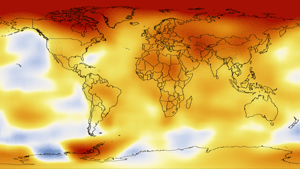
Scientists use models to learn more about current and future changes in the Earth's climate. A climate model is a computer program that uses math equations to describe how the land, the atmosphere, oceans, living things, and energy from the sun affect each other and the Earth's climate. Using these equations, models can predict how a change in one part of the climate system, such as increasing greenhouse gases or decreasing Arctic sea ice, will affect other parts of the Earth in the future.
Some people are concerned that climate models can't mimic how the world really works. But scientists have worked on these types of models for more than 40 years to make sure they get the most important things right. In the same way that video games have improved from simple graphics to very realistic scenery and action, climate models have improved to include details like how clouds form and where it might rain more.
Scientists test their models by comparing the results with real measurements. They only use models that have proven to be useful in understanding past and present changes in the Earth's climate, such as the global temperature changes recorded over the last century. As time goes on, climate scientists will have more and more data to work with, and computers will continue to become more and more powerful and get even better at predicting future climate change.
All the models agree that extra greenhouse gases will cause warmer temperatures, and improved models won't change this basic prediction.